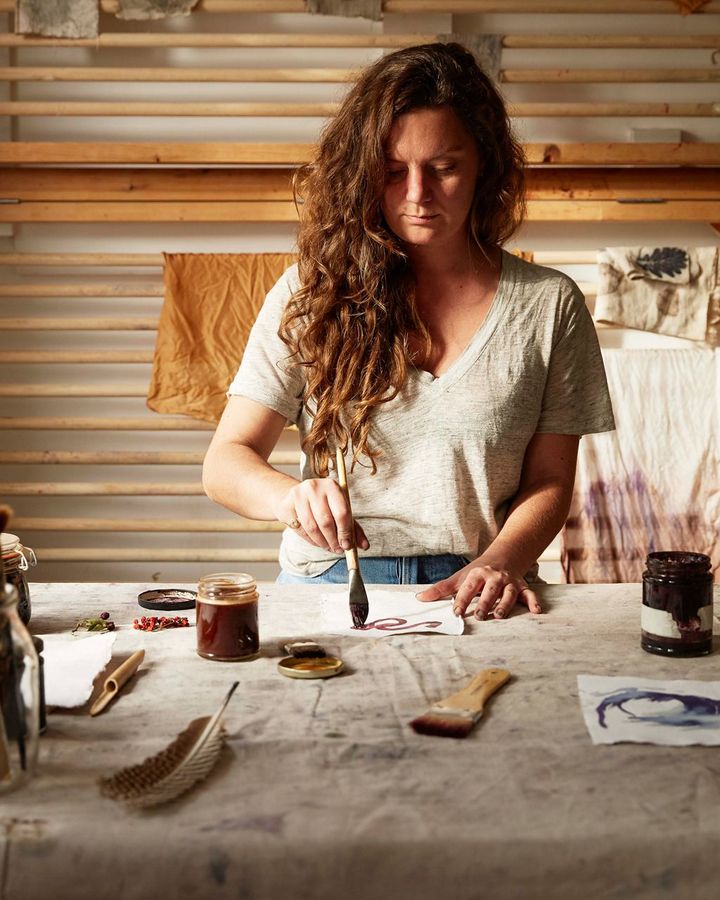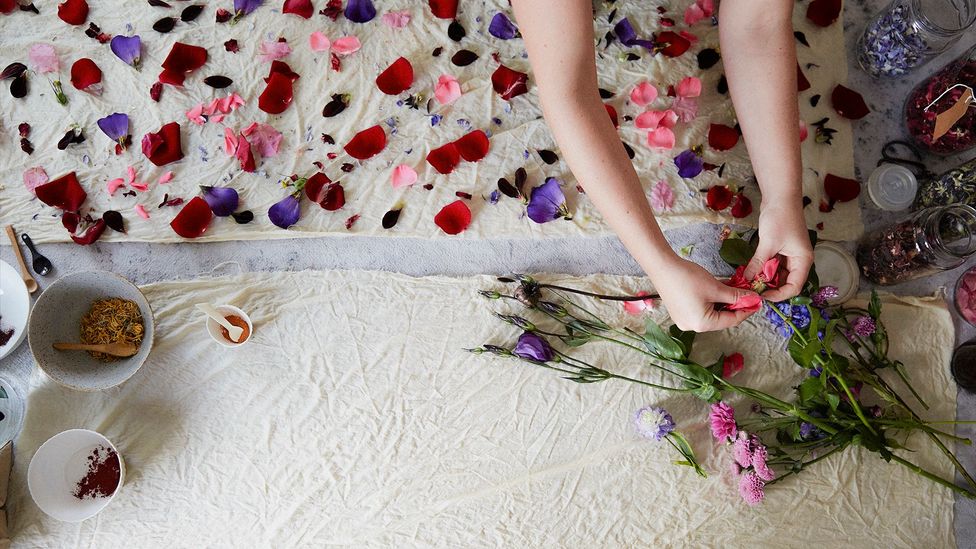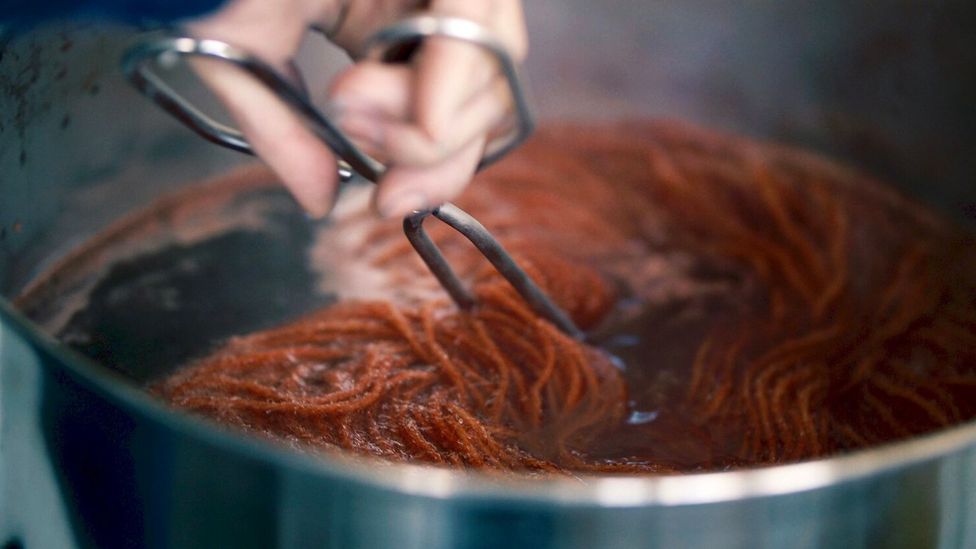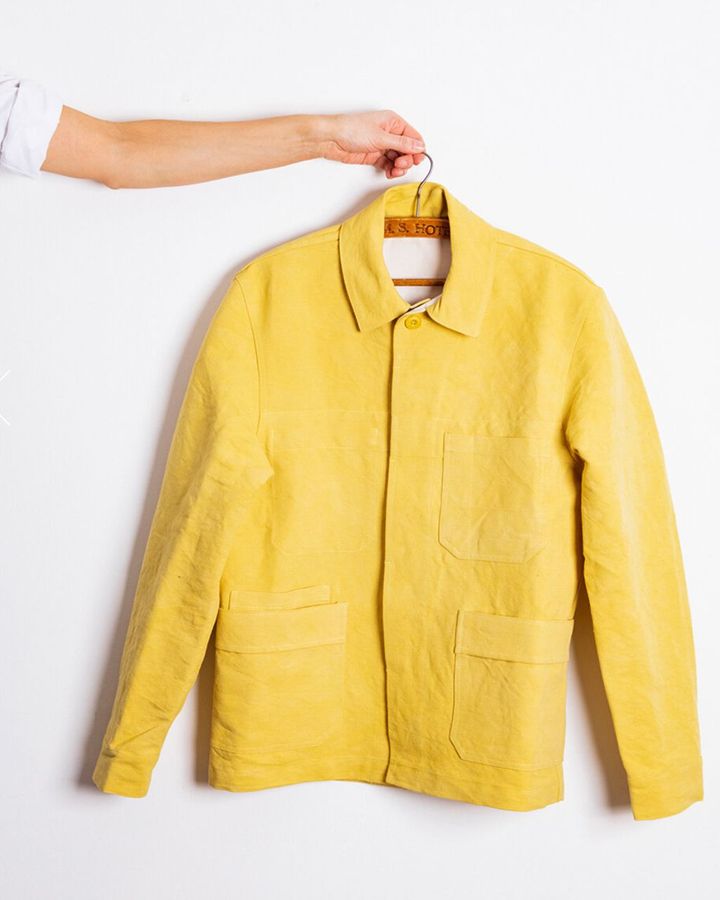Natural dye specialist Babs Behan laughs when asked about her favourite natural dye plant. “Like people, they all have such a beautiful variety of different characteristics,” she says. “But, if I had to choose one, indigo stands out. It’s not like any other dye. It’s not water soluble – so you have to go through this charming, alchemical, almost mystical process, to make it bond with the fibre. Then you take the fabric out of the water and you’ll see it turn from green to blue as it oxidises. There’s something so special about that because it’s the colour of our planet. It’s the colour of the sky and the sea – and we can’t capture it from anywhere except from this one indigo pigment.”
More like this:
– Why drawing is the best digital detox
– Eight ways to make your clothes last longer
– The rise of the ‘no-wash’ movement
Behan, a pioneer in UK-based large-scale natural dye productions, is one of a cohort of committed natural dye specialists seeing a resurgence in their craft: the dyeing of fabrics with colours derived from plants. Online courses and communities have blossomed, with more and more practitioners wanting to share their skills. Bella Gonshorovitz’s book Grow, Cook, Dye, Wear was a surprise hit in 2022, combining instructions on natural dye with plant-based recipes, vegetable growing and zero-waste clothing design. After her first successful publication Botanical Inks in 2018, Behan has just released a second, Botanical Dyes.

Babs Behan is a natural-dye enthusiast – she describes the process as “alchemical” (Credit:Kim Lightbody/ Botanical Dyes/ Quadrille)
In 2022, campaign group Fashion Revolution chose a dye garden for its Chelsea Flower Show presentation. Meanwhile, influencers on TikTok have given #plantdyeing the rubber stamp of a new generation. An ancient craft, natural dyeing is a practice whose time has come again, with hand tie-dyed fashion also making a comeback in recent years.
The resurgence has been encouraged by Covid lockdowns, “which allowed people to explore the craft at home,” says natural-dyeing enthusiast and teacher Susan Dye (who says she has “no idea whether my name tracks back to plant dyers in my family tree”.) It’s unlikely, though, that the practice would have caught on in quite the same way if not for a continually growing discomfort about fashion’s heavy footprint. From carbon emissions and animal cruelty to union busting and the reality of working in an industry when the pace is hectic and optics are everything, fashion is under considerable scrutiny. The way we colour our clothes feels late to the party – all those bright patterns hanging on clothing rails in shops come at a terrible cost.
“Put it this way, 97% of dyes used in the industry are petrochemically based,” says sustainable fashion consultant Jackie Andrews, who worked as head of textiles for Stella McCartney and helped advise the UN Ethical Fashion Initiative. “We’ve got net zero targets which mean we’re going to have to remove all those petrochemicals from the manufacturing cycle.”
Fashion is a huge polluter. According to the UN Environment Programme, the industry is responsible for up to one-fifth of all industrial water pollution – due to the fact that most clothes today are produced in poorer countries where regulation is weak and enforcement weaker still. Wastewater is dumped directly into rivers and streams; a potent cocktail of carcinogenic chemicals, dyes, salts and heavy metals that not only poison the land but also the water sources of all those, both people and animals, who rely on them. The rivers in Bangladesh’s capital Dhaka have turned black due to the sludge produced by textile dyeing and processing factories. The most polluting colour of all? Black, beloved of chic fashion editors everywhere.

Many of today’s natural dyers grow their own dye plants (Credit: Kim Lightbody/ Botanical Dyes/ Quadrille )
It’s easy to see why someone who cares about people, planet and animals, as well as clothes, might turn to natural plant dyeing. From the beauty of the raw materials – often wild plants – and the considered pace of the process; from its connection across time and continents, to the local communities it creates, plant dyeing feels like a quiet but steely act of rebellion. This is why, while beginners might start with simply changing the colour of their clothes, other worlds start to open. Many of today’s natural dyers grow their own dye plants, work on local community projects, run workshops and demonstrations, and agitate for change in industrialised fashion systems and beyond.
Five clothes-dyeing tips
- Upcycle old clothing that has greyed or faded over time with colours from plants
- Grow dye plants like marigolds for yellow, madder root for red, indigo or woad for blue
- Natural dye will only bond with natural fibre: cotton, linen, flax, silk and wool
- Take account of shrinkage while simmering – wool may shrink significantly
- Some of the natural chemicals in plants aren’t safe to digest or inhale – always work in a well-ventilated environment
The challenge – and the joy – of plant dyeing is to learn it well. “There is a lot of diversity among contemporary natural dyers, but what unites us is a love of colour and a taste for alchemy,” reflects Susan Dye. “Using a pile of unremarkable dried weld leaves to create a hank of electric-yellow yarn never ceases to give me a thrill. Dyeing requires a satisfying attention to both science and art. Whether consciously or not, successful natural dyers are masters of chemistry and biology. We learn how to extract dye molecules from plants and bind them to fibres. And in all kinds of processes, it’s important to control temperature, alkalinity, acidity.”
Dyeing the rainbow
That depth of knowledge is why most established dyers are wary of social media: “Influencers, with babies on their hip, trying to show that natural dyeing is easy – when it’s not,” warns Andrews. “Learn the science of the craft,” advises Dye. “Understanding the chemistry allows you to appreciate how vibrant and long-lasting natural dyes can be.” It’s chemistry that will also help newbies understand, for example, that “green is the hardest colour to get from natural dyes, which people think is strange as it’s the colour we associate with plants,” says Behan. “But actually it’s the living colour, whereas often, we work with dead colours – the rich reds, peaches, oranges, yellows, browns that you get in autumn.”

Natural dyes can be vibrant and long lasting – if used correctly (Credit: @wearelandlore)
Magic happens all the time in plant dyeing but first-time dyers will need to know the basics. “Natural dye only bonds with natural fibre: cotton, linen, flax, silk and wool,” points out Gonshorovitz, who has been involved with a year-long programme of demonstrations and talks exploring natural dye as a crucial link in a circular economy (a system based on re-use and regeneration of materials). “Be aware that threads are almost always polyester-made, so external stitches and buttonholes, for example, will not dye. And take account of shrinkage. Due to the high temperature required by simmering, some garments – especially wool – shrink.”
“Always wash and rinse everything thoroughly with neutral soap to allow the dye to attach easily,” advises Dye. “New fabrics are often treated with chemicals to protect against damage; even used fabrics can have traces of conditioner or dry cleaning chemicals which resist dyes. Dyeing is like decorating,” she adds. “Preparing the surface to start with is tedious but well worth it for beautiful and long-lasting results.” For dyestuffs, begin at home – with food waste. “Avocado skins and stones for pinks; used tea bags and coffee grinds for yellows; squash pumpkin skins for orange,” says Behan.
“Start with easy golden yellows from pomegranate and onion skins which don’t need any mordants [fixing substances],” says Dye. “Save dried onion skins or pomegranate rinds until you have enough to fill a large saucepan. Simmer for an hour and strain before use. You can dye your items by long cold soaking or by heating in the dyebath until the colour is deep enough for you.” Due to high tannin content, the colours last well on cellulose fabrics like cotton, linen and hemp, even without mordanting, the process of fixing colour to fabrics. In natural dyeing, common mordants include iron and aluminium potassium sulphate, but also rhubarb leaves and plant-based milks. In fashion production, mordants might include benzidine, which has been linked to pancreatic cancer. That fact alone re-emphasises the contrast between synthetic and natural processes.
Clothes dyeing in numbers
- The fashion industry accounts for nearly 20% of wastewater
- 97% of dyes used in the fashion industry are petrochemical-based
- Textile dyeing is the second largest polluter of water globally
- Around 70 million barrels of oil a year are used to make polyester fibres in clothes
“DIY natural dyeing can be a bit punk, empowering and subversive. It requires no specialist equipment,” says Dye. “Upcycle old clothing that has greyed over time with natural colours from outside like eucalyptus, red dock, spring nettles, dandelion root,” says Behan. Revel in the results but remember to not over-romanticise botanical dyes. “Not everything that is natural is safe,” warns Gonshorovitz. “Some plant chemicals aren’t safe to digest and even inhale.” Always work in a well-ventilated environment and keep equipment used for food and dyeing separate.

Tie-dye, pictured here at Copenhagen fashion week, is having a resurgence (Credit: Getty Images)
Most of all, practitioners revel in a renewed connection with nature: “That’s the beauty [of natural dyeing]: that people can start to recognise plants,” says Andrews. “If we taught students to use natural dyes, they’d actually learn about the plants around them.” Earlier this year, Andrews hosted a Dyers Circle, with “100 Hues” of natural colours, at the Future Fabrics Expo in London’s Greenwich. “I literally just picked stuff on the wayside as we went in,” she laughs. “There was dock and cow parsley or Queen Anne’s Lace, a common source of yellow. Oak, of course. All the basics we used consistently up to the 1800s, when London was a wonderful dye centre. You have got basic madder, indigo, weld,” she continues.
But the real surprise comes, she says, with the sheer variety of indigenous flowers. Andrews has been researching the diversity of dye stuff used in Europe at Kew Gardens. “It’s fantastic. The list just goes on and on.” While the West works at reconnecting with its long history of natural dyes, indigenous cultures provide a continuous and exciting source of inspiration for practitioners. “One of my first experiences with natural dye was on a trip to Mexico in 2016, visiting the natural-dye workshops of Oaxaca,” says Gonshorovitz. “I am still fascinated by the way they practice there.”
Glossary
Mordant – a substance that fixes dye
Circular economy – an economic system based on the reuse and regeneration of materials
Fugitive dye – impermanent dye
During her final year studying fine art and textiles at University of the Arts London, Behan travelled to India to explore natural dyes and block printing in Jaipur. “Local materials, pigments, fabrics, papers and wooden hand-carved blocks; everything handmade and 100% biodegradable and incredibly beautiful in a way that mass-produced prints aren’t: it made a lot of sense to me.” Since then, she has travelled the world, experimenting with other traditions. “In Peru, it’s hand-dyeing yarn and weaving. In Indonesia, it’s batik. [Natural dyeing] has a different character depending on plants and material and culture.” Her experiences have given her practice greater depth.
The future for natural dyeing is as bright as the colours it offers. London College of Fashion’s Sarah May has been advocating for a dye garden at the college’s new site in East London. “Support from the students has been really positive; young people are really engaged,” she says. Course leaders and students across modules are exploring the possibilities of natural dyes in print, in embroidery, and in innovative bio-based formulas.

Golden yellows can be created from pomegranate and onion skins (Credit: The Good Life Experience/ Something Good)
“I’m really inspired by the current ‘new wave’ of dyers, who are versed in the scientific background but are happy to experiment with non-traditional dyes, different mordanting methods and fugitive [impermanent] dye” says Gonshorovitz. “I love the serendipity of natural dyeing, the fact that it would be hard to replicate the same shade – and the fact you can reinvigorate garments you already own in that way, rather than buy new ones for novelty. Natural dye embodies the rather technical term of circularity so well. It reminds us that all we consume comes from and returns to nature.”